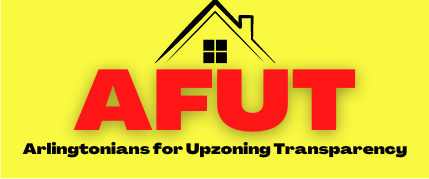At today’s YIMBYs of Northern Virginia (YIMBYs NoVa) Rally, speakers continued to falsely portray the County’s “Missing Middle Housing” (MMH) Plan as helping low and moderate-income residents. This has been the group’s mantra.
YIMBYs of NoVa co-founder Luca Gattoni-Celli, an Alexandria resident, wrote to the Arlington County Board in support of its MMH Plan, stating: “Fewer school teachers and staff will have to commute dozens of miles each day to work in the communities where they contribute so much. More low-income retail and service sector workers will be able to live near their jobs. More first responders, sanitation workers, and librarians will be able to live in the neighborhoods they serve.”
But even Arlington County acknowledges that the Plan will not help these residents. “Under both the status quo and the proposal for expanded housing options households earning less than $100,000 do not earn sufficient income to purchase or rent homes in R-5 to R-20 zones.” (Attachment 9, page 12)
The reality is that Arlington teachers, firefighters, and police officers, with average annual incomes of $62,198, $70,118, and $68,600, respectively, will not benefit from the MMH Plan.
What is worse for those with low or moderate incomes is that County staff have underestimated their stated $670,000 cost of a one- to two-bedroom unit in a 6-plex. At the AfUT/ASF (Arlingtonians for Our Sustainable Future) January 8 Reality Check Rally, attended by more than 500 people, a mortgage loan specialist explained why a household income of $173,813 would be required to purchase such a unit. That is 136% of Area Median Income (AMI), which is considered upper income – and more than two and a half times the median income of Arlington African American households ($66,781) and about twice that of Arlington Latino households ($86,513).
Who are the YIMBYs? The national movement started in northern California in 2013.
According to the organization, Housing is a Human Right: “YIMBYs started with a self-serving agenda — to force the production of more luxury housing that they could live in — no matter the consequences to working-class communities. To further their agenda, YIMBYs co-opt housing justice messaging, but they’re not housing justice activists.”
This is exactly what is playing out in Arlington’s MMH Plan debate. “It has become clear that YIMBYs and the County Board are on the same page, wanting residents to think that the MMH Plan is about affordability, when in reality, those who will benefit are developers and upper-income earners, many from outside Arlington,” said David Gerk, AfUT member. He continued, “The County’s last-minute rebranding of its MMH Plan to ‘Expanded Housing Options’ (EHO) is smoke and mirrors. Instead, let’s call it what it is – Exclusive Housing Options.”
The MMH Plan has nothing to do with affordable housing, or with fair housing. But instead of focusing on the facts, today’s speakers suggested that the County’s Missing Middle Housing Plan is at the center of promoting fair housing in Arlington.
The 216-page January 2023 draft Metropolitan Washington Regional Fair Housing Plan for Arlington barely mentions missing middle housing. Instead, the report focuses on increasing the supply of housing for low and moderate-income families, preventing displacement of these families, and promoting home ownership. Arlington’s MMH Plan advances none of these goals.
In fact, economists estimate that the MMH Plan will cause housing prices to increase, will lead to further gentrification in the County, and will displace lower income residents – all undermining the goals of fair housing. Gentrification and displacement are most likely for the most vulnerable residents – renters, persons with disabilities and seniors.
Arlington’s land use policy, has been a national model touted as “one of the country’s most recognized examples of smart-growth, sustainable, and transit-oriented development, while reducing commercial sprawl and conserving the quality and diversity of neighborhoods.”
The County’s current GLUP (General Land Use Planning) goals are to:
- Increase the supply of housing by encouraging construction of a variety of housing types and prices at a range of heights and densities in and near Metro Station Areas.
- Preserve and enhance existing single-family and apartment neighborhoods.
The MMH Plan Zoning Ordinance amendments are inconsistent with these GLUP goals and the proposed GLUP amendments do not change these goals.
The YIMBYs misleading claims go beyond affordability and fair housing. The YIMBYs NoVa website states that the County’s MMH Plan will allow more people to live near transportation. But the reality is that the Plan does not incentivize development of multi-family buildings along transit or close to amenities. Instead, these units could be built on ANY residential lot in the R5 to R20 Zoning Districts, whether they are accessible to transit or not. (See the County’s own transit-proximate map.)
One area where AfUT and NIMBYs NoVa agree is that there is a lack of proper infrastructure to support the increased density that the County is about to approve. In his letter to the Board, Gattoni-Celli stated: “Some Arlington residents have legitimate concerns about infrastructure issues such as school crowding, flooding and tree canopy. These concerns must be addressed . . . The County should appropriately invest in infrastructure to support badly needed development.”
Three out of four residents who responded to the County’s own MMH Plan survey opposed it, and more than 5,700 people have signed a petition objecting to the Plan. And more continue to express their concerns as they learn that the Plan is not about affordability, but only about making Arlington – the 11th most densely populated county in the nation – even more dense.
Media Contact: AfUT, AFUT.UpzoningTransparency@gmail.com
